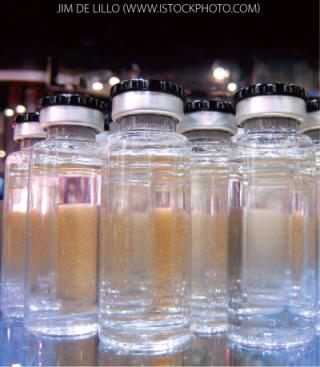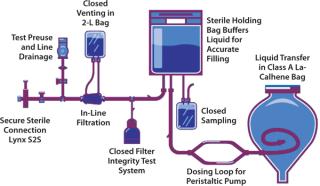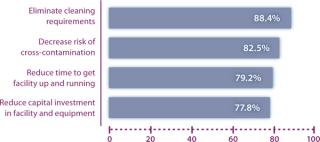Fill–finish is the final operation in manufacture of sterile products (except for terminally sterilized products). This process requires sophisticated technology and machinery in a highly controlled, aseptic environment. Fill–finish assemblies must meet stringent requirements to ensure flow-path sterility and integrity, ensure operational safety and efficiency, and provide fill-volume accuracy to exacting requirements.
Traditional fill–finish machinery comes as fixed systems comprising complex components that require assembly, cleaning and sterilization, disassembly, and material storage after filling is complete. Those operational steps allow for an open flow path, creating the possibility of contamination or sterility breach and subjecting operators to hazardous materials. Time-pressure and piston-pump systems are the predominant methods for dosing and filling. They require assembly, open flow paths, and validated clean-in-place (CIP) and/or steam-in-place (SIP) protocols to ensure a high probability of sterile final-product flow paths.
Because of their extensive use of stainless steel components, traditional fill–finish facilities are considered to be inflexible. They involve long change-out times and high operating costs due to CIP, SIP, labor, and facility expenses. Validation of cleaning and sterilization processes; lengthy, labor intensive set-up; and validation and training of procedures to ensure repeatability of a process all contribute to creating a bottleneck when time to market is essential.
The nature of those fixed systems is at odds with a market that is undergoing rapid transformation. Smaller batch sizes, increasingly varied product portfolios, and intensifying pressure to reduce costs and speed time to market are incompatible with traditional fill–finish equipment. The presence of highly potent ingredients can place additional demands on cleaning processes and put operators at even more risk.
Benefits of Single-Use Fill–Finish
A number of pharmaceutical manufacturing steps upstream of this stage are increasingly moving toward single-use solutions to increase operational flexibility, reduce contamination risk and capital investment, and eliminate cleaning while bringing a higher level of safety to operators. Potential benefits of single-use systems are significant and include reduced contamination risk; elimination of cleaning and sterilization; reduced validation and set-up time; and improved safety, efficiency, and costs.
Single-use assemblies — including those for fill–finish — are an option for new facilities as well as for retrofitting existing plants. Single-use technology is finding its way into many unit operations, bringing increased flexibility especially to many contract manufacturing organizations. Here we describe conversion of a traditional, fixed fill–finish system to a flexible, single-use operation. This example illustrates how single-use filling systems can be incorporated into newly built and commissioned manufacturing facilities.
Case Study
To meet tight production timelines and market demands for a pandemic influenza vaccine, a large biologicals manufacturer sought to increase the speed and efficiency of its filling unit operations. Single-use fill–finish systems were evaluated as a way to increase production without increasing manufacturing footprint.
The manufacturer’s original process involved a restricted-access barrier (RAB) unit and standard stainless steel process lines with in situ installation requiring CIP/SIP. This multidrug facility had installed hardware connected to hard-piped connections, limiting operational flexibility. In addition, those connections created a risk of multiple potential leak points. In situ installation also brings the risk of contamination.
Single-Use Fill–Finish Components: To address this customer’s challenges, EMD Millipore developed a Mobius single-use fill–finish assembly incorporating a disposable La Calhene alpha port and beta bag from Getinge USA, Inc. (Rochester, NY). This solution combined expertise in sterile barrier transfer and disposable fluid-path management to rapidly yield a validated solution. The assembly was fabricated, integrity tested, and validated for flow-path sterility and assurance of sterile barrier at EMD Millipore.
The assembly (Figure 1) consists of a filter module connected to a 50-L header bag, which is connected to a pump line and needle assembly. For the isolator extension, we added a Getinge La Calhene alpha port to the current RAB. That permits sterile transfer of fill lines and needles through the connection to a mating, disposable Getinge LaCalhene beta bag. The flow path is self-contained and has limited assembly, which increases operator safety and decreases risk of contamination compared with a traditional system. The hard-piped, time-pressure filling module remains in place, but it is not used for this filling operation because of the time requirements of validation, operational cleaning, and so on. It does remain in place for filling legacy products.
The transformation was enabled by a roll-up peristaltic pump skid. Addition of that skid and a single-use fill–finish assembly greatly increased the use and flexibility of the company’s filling line both for this flu vaccine and for new drug forms in the future.
Validation
Successful implementation of this or any single-use system goes well beyond simply assembling piping, tubing, and fittings. Success is highly dependent on access to a team of experienced systems integrators with strong process knowledge, experience in validating systems, and thorough understanding of your particular fill–finish requirements (and potential risks). Suppliers of such systems should offer the insights and skills necessary to become your external validation partner.
For example, validation of fill–finish systems can be managed by EMD Millipore’s Access Services team and includes
- Materials compatibility testing of disposable components relative to a manufacturer’s requirements
- Extractables analysis for individual assembly components and the full assembly; USP Class VI certification of materials following gamma irradiation
- Packaging validation, including integrity and sterility testing after ISTA (International Safe Transit Association) testing
- Assessments to ensure that packages arrive in an integral state, that the outside of products rem
ain sterile, and that product packages protect integrity and sterility of flow paths - Flow-path bioburden and sterility testing to meet guidance document standards from the Association for the Advancement of Medical Instrumentation (AAMI), the American National Standards Institute (ANSI), and ISO 11137 from the International Organization for Standardization
- Integrity testing for products used in manufacturing
- Validation for a sterile flow path and barrier for each product
- Assurance of sterility and integrity of products throughout their shelf lives.
If a manufacturer requires additional work for submissions involve custom assemblies, then the systems integrator should offer and manage that as well.
The Bottom Line
Figure 2 compares the traditional fill–finish operation with one using single-use technology for this case study. Cleaning and set-up time was reduced from 14 hours to less than one hour. The disposables configuration reduced set-up time by 75% by eliminating cleaning and installation of steel components inside the cabinet. This reduced Grade A intrusion time from hours to minutes. The number of aseptic connections was reduced from 50 to zero. Use of a flexible flow path minimized the number of potential leak points because of the tubing and connections’ expansion and contraction properties. Cleaning validation was eliminated.
Filling time was reduced from 24 hours to 10 hours, which increased the average number of vials filled per hour from 3,000 to 10,000. Overall, the campaign fill time was shortened from 36 hours to 12 hours per campaign. With the new single-use fill–finish configuration, the rate-limiting factor in manufacturing becomes the material rather than the facility itself. The new process required less than six months to commission. Among the 85 million doses filled to date, there have been zero contaminations. With the new configuration, equipment use increased from 35% to 82%, and energy use dropped significantly when CIP and SIP were eliminated.
Table 1: Comparing traditional and Mobius fill–finish processes at a vaccine manufacturer
Implementation of a single-use fill–finish system enables flexible manufacturing, even for facilities in which an existing system must be retrofitted. The additional flexibility afforded by disposables is applicable to both single and multiproduct filling operations, which can be run in simultaneous campaigns using the same hardware.
Implementation of single-use fill–finish for this vaccine manufacturer delivered a set of benefits that align with the top reasons for use of disposables as reported in a recent survey (Figure 2). Cleaning requirements were reduced, as were the risk of cross-contamination set-up time, and capital investment.
Fewer intrusions and higher sterility assurance level (SAL) reduces risk, evidenced by 85 million doses filled without a single contamination. In this case, use of a disposable assembly has a SAL of 10−6 due to validation of gamma irradiation of the assemblies. Finally, efficiency is increased by removing CIP/SIP as well as more efficient installation and operation.
Further Information
The webinar library at www.millipore.com/ webinars offers webinars on implementing a single-use fill–finish system and risk-based assessments of extractables and leachables, as well as “Fill–Finish 101: Introduction to Implementing a Single-Use Solution.”
Author Details
Ernie Jenness is process solutions product manager (ernie.jenness@merckgroup.com), and Vikas Gupta is process solutions group product manager (vikas.gupta@merckgroup.com) for EMD Millipore, 290 Concord Road, Billerica, MA 01821; 1-978-715-4321; www.millipore.com.




